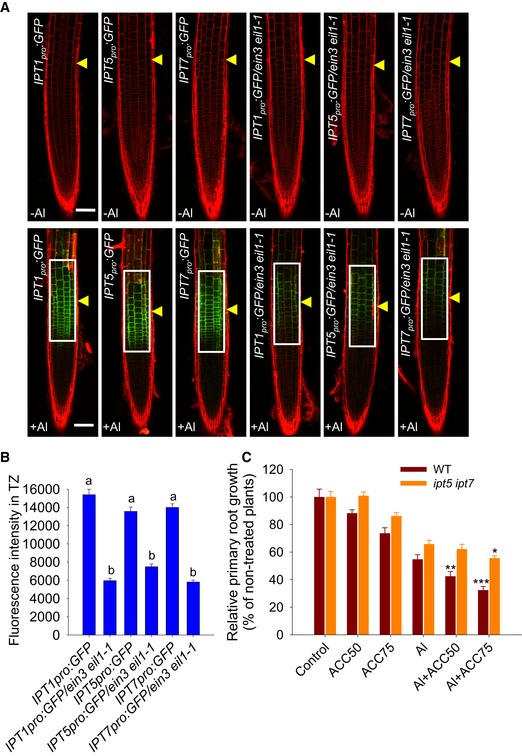Six‐day‐old IPT1
pro
:GFP, IPT1
pro
:GFP/ein3 eil1‐1, IPT5
pro
:GFP, IPT5
pro
:GFP/ein3 eil1‐1, IPT7
pro
:GFP, and IPT7
pro
:GFP/ein3 eil1‐1 seedlings were exposed or not (control) to 25 μM AlCl3 for 2 h. Cell boundaries appear red following propidium iodide staining. The TZ is marked by yellow arrowheads. Scale bar: 100 μm. The detected fluorescence region in (B) is marked by white rectangles.
Quantification of the Al‐induced fluorescence intensity in the TZ of IPT1
pro
:GFP, IPT1
pro
:GFP/ ein3 eil1‐1, IPT5
pro
:GFP, IPT5
pro
:GFP /ein3 eil1‐1, IPT7
pro
:GFP, and IPT7
pro
:GFP /ein3 eil1‐1 seedlings. Cell boundaries appear red following propidium iodide staining. The data are shown as mean ± SD (n = 15) with one‐way ANOVA and Tukey's test. Different letters indicate significant differences (P < 0.01).
Root growth of the WT and the ipt5 ipt7 mutant was affected by a 7‐day exposure to 6 μM AlCl3 with or without 50 and 75 nM ACC. The data are shown as mean ± SD (n = 3). *, **, and ***: means differ significantly within ACC treatment in the presence of AlCl3 in the WT (dark red) or ipt5 ipt7 mutant (orange) at, respectively, P < 0.05, P < 0.01, and P < 0.001 (t‐test). At least 60 seedlings were analyzed from three biological repeats (around 20 seedlings for each repeat).

